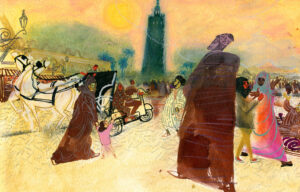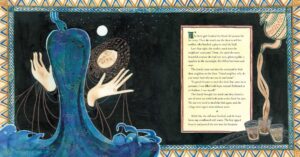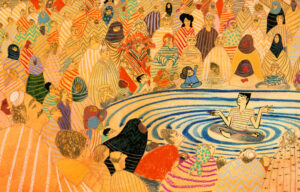 The Storyteller
The Storyteller
By Evan Turk
Atheneum (an imprint of Simon & Schuster)
$24.99
ISBN: 9781481435185
Ages 4-8
On shelves June 28th
Credit the internet age for doing what the television age never could. I don’t know if you’ve noticed, but there is a movement around the world that can be interpreted as nothing so much as a direct response to our digital age. You may have noticed it in small things, like the rise of Steampunk or the sudden surge of interest in Maker stations and the kinds of “hacking” that look suspiciously similar to activities found in shop class in days of yore. All this comes about because people have come to believe that we do not create enough tangible objects in our day-to-day lives anymore. And while this is true, let us not forget that we do not create enough intangible objects either. I’m talking about storytelling, that ancient artform that is currently seeing a worldwide resurgence. It isn’t just the increase in storytelling festivals and podcasts like The Moth here in the States. Young people in countries worldwide are doing what their elders have desired for decades; they’re asking to be told a story. Taking his cues from the newfound interest of young Moroccans in Marrakech in the ancient storytelling tradition, author/illustrator Evan Turk uses the folktale format to craft an original story about storytelling, weaving, history, and language. The end result is a twisty turny story within a story within a story that challenges young readers even as it lures them in.
Once, in the great country of Morocco, storytellers flourished and the cities’ fountains flowed with cool, clear water. As time went on the people became comfortable and forgot about the storytellers, and so they disappeared over the years. So too did the fountains dry up, until one day a boy went looking for some water. What he found instead was an old storyteller. As the man told his tale he would end his story with a story within a story and the boy would find his brass cup filled with liquid. Even as this was happening, however, a desert djinn saw the drought as an opportunity to reclaim the cities that had previously held him back with their fountains. Yet when the djinn was set to level his town, the boy managed to delay him with his storytelling. And as he wove his tale, the people were able to refill their fountains until finally storytelling and water ran freely in the cities once more.
 My brain is not what it used to be. Remind me again. What’s that term for a story that tells a story that tells a story that ends only when the innermost story doubles back and each tale is finished in turn? Is there a word such a thing? I suspect that the storytellers amongst us would know. The most obvious similarity to this book that comes to mind is, of course, the tale of Scheherazade. Indeed, the boy uses his stories to trick the djinn. And what could be a more natural comparison? In both tales it is storytelling that proves to be the saving of us all. Our thirst is quenched and we are tied to our history like never before. The obvious question then is whether or not Turk’s text is too complex for kids to follow. Sure, he distinguishes between the tales with different colored fonts, but will that be enough to allow them to remember what came before as they plunge deeper and deeper into the narrative? I think there may be some confusion at work, certainly. I wouldn’t necessarily hand this to a three or four-year-old. However, Turk’s text takes pains to remind the reader where the tale was before. The art helps as well. Confusion, such as it is, will be held to a minimum.
My brain is not what it used to be. Remind me again. What’s that term for a story that tells a story that tells a story that ends only when the innermost story doubles back and each tale is finished in turn? Is there a word such a thing? I suspect that the storytellers amongst us would know. The most obvious similarity to this book that comes to mind is, of course, the tale of Scheherazade. Indeed, the boy uses his stories to trick the djinn. And what could be a more natural comparison? In both tales it is storytelling that proves to be the saving of us all. Our thirst is quenched and we are tied to our history like never before. The obvious question then is whether or not Turk’s text is too complex for kids to follow. Sure, he distinguishes between the tales with different colored fonts, but will that be enough to allow them to remember what came before as they plunge deeper and deeper into the narrative? I think there may be some confusion at work, certainly. I wouldn’t necessarily hand this to a three or four-year-old. However, Turk’s text takes pains to remind the reader where the tale was before. The art helps as well. Confusion, such as it is, will be held to a minimum.
I first knew of Turk’s work when he illustrated Bethany Hegedus’s Grandfather Gandhi. In that book he integrated real spun cotton threads into the art, knowing full well the importance spinning had to Gandhi and his followers. In this book, weaving is the craft of choice so I wondered, not without reason, if woven threads would make their way into the art. As it happens, there are plenty of water-soluble crayons, colored drawing pencils, inks, indigo, sugared green tea, and even art created by heat gun and fire in the illustrations, but nothing so simple as thread. Turk mentions this on his publication page and he puts a little note to the reader there as well. It reads, “Look for a blue glimmer of hope to appear around each story!” and a small blue diamond appears. Naturally, I was curious so I looked. Sure as shooting, after each story’s text a diamond appears. However, as the stories appear within stories within stories, the diamonds grow more elaborate and decorative. Then, as the stories end one by one, the diamonds simplify once more. I began searching the art for more diamonds and here Turk doesn’t disappoint. If you look closely at the borders of the book, you see that the diamonds appear when there is hope and fade from blue to brown diamonds when hope dries up. As the storytelling increases the borders fill in more and more blue, just as the townspeople fill their fountains with bowl after bowl of water. Point out to a child reader the diamond motif and you are sure to be surprised by all that they find hidden in these pages.
 I should probably say something about Turk’s art itself. When I reviewed Grandfather Gandhi I had difficulty putting into words precisely what Turk does with his images. So I looked at the book’s professional reviews. His art causes reviewers to use terms like “dynamic visuals”, “stylized” and “strikingly patterned”. They say his art displays “bold, expressive imagery” or that he “mixes carefully detailed renderings with abstracted expressions of emotional struggle.” I agree with all of that but no one mentions his faces and hands. The patterns here are striking and upon closer inspection they yield such marvelous details it wouldn’t take much for this art to spin wildly out of control, opting for an abstract approach to the proceedings as a whole. Instead, Turk centers his art through the hands and faces of his characters. Look closely and you’ll see what I mean. The old storyteller’s hands are gnarled and wonderfully expressive, even as his audience of one clutches a single brass bowl. The hands of a cunning neighbor stroke her child as she schemes, while a princess, escaping on the night before her wedding, holds up her hennaed hands in despair. Hands. Heads. Hearts.
I should probably say something about Turk’s art itself. When I reviewed Grandfather Gandhi I had difficulty putting into words precisely what Turk does with his images. So I looked at the book’s professional reviews. His art causes reviewers to use terms like “dynamic visuals”, “stylized” and “strikingly patterned”. They say his art displays “bold, expressive imagery” or that he “mixes carefully detailed renderings with abstracted expressions of emotional struggle.” I agree with all of that but no one mentions his faces and hands. The patterns here are striking and upon closer inspection they yield such marvelous details it wouldn’t take much for this art to spin wildly out of control, opting for an abstract approach to the proceedings as a whole. Instead, Turk centers his art through the hands and faces of his characters. Look closely and you’ll see what I mean. The old storyteller’s hands are gnarled and wonderfully expressive, even as his audience of one clutches a single brass bowl. The hands of a cunning neighbor stroke her child as she schemes, while a princess, escaping on the night before her wedding, holds up her hennaed hands in despair. Hands. Heads. Hearts.
There’s been a lot of discussion lately about diversity in children’s literature. Specifically, some of that discussion has concerned those books written by white people about other cultures. It’s not a new phenomenon but what is a bit new is the increasing understanding that if you are going to use another culture, you need to do your homework. If, for example, you are setting a story in Morocco, then you need to make the readers understand why you made that choice. That it wasn’t arbitrary. This is yet another of the many reasons I’m so impressed with Turk’s work here. That he sets his story in Morocco (contemporary Morocco, by the look of it) is deeply purposeful. The Author’s Note at the end explains further. From this we learn that Morocco’s public storytellers or hlaykia have told tales for “nearly one thousand years” and yet “Only a handful of master storytellers remain”. All is not lost, though. Renewed interest in storytelling has surfaced, specifically at a restaurant called Café Clock in Marrakech. Turk then closes with a small Bibliography of sources on everything from storytelling to carpet weaving. The book then is not an appropriation of an “exotic” culture done on a whim but rather a considered, thoughtful selection that serves as an ideal setting for a tale about storytelling then, now, and in the future.
 It was once part of a children’s librarian’s training to know how to tell a story from memory. Here in America it was even considered part of a children’s librarian’s heritage, though in the last few decades it has been fast forgotten. There are still pockets that remember, though. That’s why books like Turk’s give me the oddest little sense of hope. As I mentioned before, storytelling everywhere is seeing renewed interest. It seems odd to say, but this book, wrapped as it is in classic motifs and themes dating back hundreds, even thousands, of years, is one of the freshest, most timely picture books I’ve had the honor to read in a long time. Visually stunning with a storyline to match, Turk is beginning to make good on his talents. This is a man with storytelling in his blood and bones. Our children reap the rewards. A can’t miss book.
It was once part of a children’s librarian’s training to know how to tell a story from memory. Here in America it was even considered part of a children’s librarian’s heritage, though in the last few decades it has been fast forgotten. There are still pockets that remember, though. That’s why books like Turk’s give me the oddest little sense of hope. As I mentioned before, storytelling everywhere is seeing renewed interest. It seems odd to say, but this book, wrapped as it is in classic motifs and themes dating back hundreds, even thousands, of years, is one of the freshest, most timely picture books I’ve had the honor to read in a long time. Visually stunning with a storyline to match, Turk is beginning to make good on his talents. This is a man with storytelling in his blood and bones. Our children reap the rewards. A can’t miss book.
On shelves June 28th.
Source: F&G sent from publisher for review.
Like This? Then Try:
- Frederick by Leo Lionni
- Tell Me the Day Backwards by Albert Lamb, ill. David McPhail
- The Girl Who Saved Yesterday by Julius Lester, ill. Carl Angel
Misc:
See more images from the book here.



The Charlotte-Mecklenburg Library has a group dedicated to promoting traditional storytelling and we get a lot of calls for tellers to come out for events. You’re right, Betsy–there is a resurgence of interest around the world and I think it is indeed a response to our digital age. People want the connection to other people and not necessarily to machines–at least, not all the time. But this is not new. Way back in the late ’70’s and early ’80’s, when videos were first coming out, the majority opinion was that movies in movie theatres would become extinct. Why would anyone spend all the time and expense to go out to a movie when they could watch them in the comfort of their own homes? But then a book called Megatrends by John Naismith came out around 1983 that predicted just the opposite. It said that movies were not just entertainment but community events. People like to experience the same things together and that’s why movies would remain. And he was right. Maybe that’s why there’s a renewal in storytelling. People want to experience something together and break out of their isolated cocoons. It’s amazing to see–all kids (and adults), no matter what background, will sit quietly and entranced when someone starts telling a story.
Great review.
I believe the term is ‘Nested Tales” The Panchatantra is written in this form.